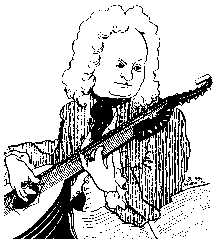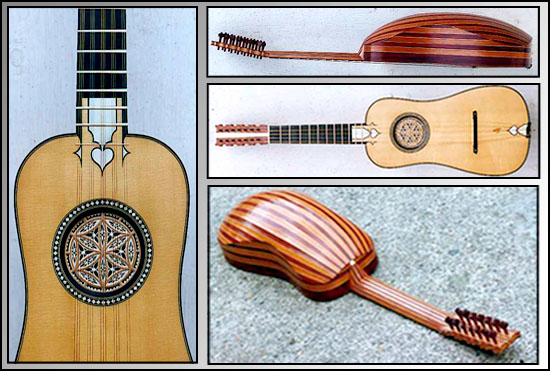Germany
In the XVII
century lutes began to change. We see one peg box, all strings
are the same length and string baking became quite sophisticated.
Extensions on the lute were not necessary and the only notation
used in Germany as well as in the rest of Europe was French
tablature.
Among the most important composers of this period we
have:
David Reusner (1636-1670) Born
in Saledia (Poland) who wrote three important books in 1667
and 1676 and a third book containing harmonized sacred melodies
in 1678.
David Kellner (1670-1748)
wrote the first theory book based entirely
on major and minor keys and was used as a text for many
years after his death. His lute book contains 17 pieces, mostly
dances of a mostly rigid character and fantasias in a freer
and more improvisational style.
Silvius Leopold
Weiss (1686-1750)

Weiss fuses Italian driving rhythms and French tonal qualities
in an impressive output of nearly 600 solo movements for the
lute, of which only one was published during his lifetime. He
wrote eleven incomplete Sonatas, eighty Partitas and most of
it can be found in suites of six movements; Allemand, Courant,
Bourée, Saraband, Minuet and Gigue, often with a Prelude
at the beginning. This repertoire is highly accessible to modern
day guitarists and has been recorded by many fine players. His
style is late Baroque similar to J.S. Bach but lest contrapuntal,
with some influences of style galant.
In the course of his career he wrote movements that progressively
became more extended, coordinating thematic material with an
harmonic structures similar to that of the classical sonata
He was born to a German family of lute players and studied with
his father Johann Jacob. In 1760 he was at the service of Count
Carl Philipp in Breslau. He wrote his first Partita in 1720
when he was visiting the court of Count Dusseldorf’ brother.
Between 1708 and 1714 he lived in Italy with the Polish prince
Alexander Sobiesky. The prince lived in Rome with his mother
and the mother Queen, Maria Casimira, who hired Alessandro Scarlatti
and later in 1709, Domenico Scarlatti, to serve as musical director
in the court. Weiss worked with both Scarlatti’s and was
exposed to the music of Corelli and other composers in Rome.
After the prince’s death in 1714, Weiss returned to Germany,
and in 1715 was briefly employed in the court of Essen-Kassel
in Dusseldorf.
In 1718 he is hired as a high paying member of the Royal Chapel
of Dresden, unfortunately his performing career was cut short
when a French violinist called Petit, attacked him and chewed
his index finger, affecting his playing permanently.
Weiss traveled throughout Europe. He was in Prague in 1717,
in London in 1718 and in Vienna in 1718-19. In 1722 he played
in the Bavarian Court in Munich with flautist, Buffardin He
also visited Johann Sebastián Bach in Leipzig in 1739
and probably saw him again in Dresden when Bach visited his
son Wilhelm Friedemann Bach.
Johann Sebastian Bach (1685-1750)

Even though Bach owned a lute he did not play
it but he was keenly aware of the music of Weiss and of his
talents as a lute player and composer.
J.S. Bach did not write music for the guitar
but he wrote four suites for the Lute. Guitarists play many
transcriptions of his music and the most played ones are:
Six
Cello Suites, Six Sonatas and Partitas (three of each), Four
Lute Suites, Prelude Fugue and Allegro BWV 998 ( title page
for Lute or Cembalo), Prelude in Cm part of the keyboard Preludes
(d minor on guitar) and Fugue BWV 1000 usually performed with
the Prelude, an arrangement of a G minor violin sonata played
in A major on guitar.
Many modern players have arranged other music of J.S Bach from
the clavichord and the violin, with differing results. Transcriptions
vary from player to player and the most successful ones are
those that avoid awkward fingerings but preserve the true spirit
of the music.
|



